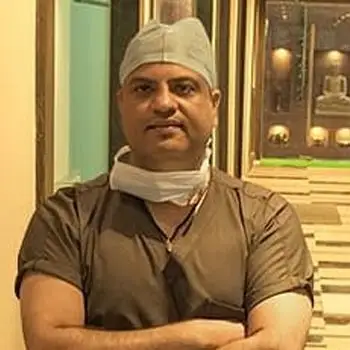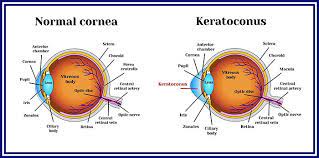CORNEAL AND OCULAR SURFACE PROCEDURES-C3R (UV radiation Crosslinking- for keratoconus) - Single Eye
India
-
Our Price USD 777
-
Hospital Price USD 818
-
You Save : USD 41
Booking Amount: USD 78. Pay Remaining 90% at the hospital.
Book NowAdditional Credit
Among the important extras we offer as part of the Additional Credit are the following:
-
Site Tourism For The Patient & Attendant
-
Airport Pick & Drop Service
-
Ambulance service at airport
-
Priority appointments with The Doctor
-
Cancel Easily Anytime with Full Refund
-
Room Upgradation
-
Free Online Doctor Consultation Valued at USD 20
-
Free hotel Stay for 5 to 7 days Accordingly
-
Welcome Kit at Arrival
-
Interpreter
-
Medical Visa Assistance
What is Included?
- Doctor consultation charges
- Lab tests and diagnostic charges
- Room charges inside hospital during the procedure
- Surgeon Fee
- Cost of implant
- Nursing charges
- Hospital surgery suite charges
- Anesthesia charges
- Routine medicines and routine consumables (bandages, dressings etc.)
- Food and Beverages inside hospital stay for patient and one attendant.
What is not Included?
- Extra Radiology Investigations
- Healthcare Professionals Charges of other consultations.
- Other Requested Services such as Laundry etc.
- Additional Pharmaceutical Products and Medicines After Discharge from Hospital.
- Management of Conditions Unrelated to Procedures or Pre-Existing.
- The cost of any additional implants will be in addition to the package cost.
Package Description
CORNEAL AND OCULAR SURFACE PROCEDURES-C3R (UV radiation Crosslinking- for keratoconus):
Collagen Cross Linking is a new therapy option for keratoconus that tries to halt the evolution of the condition. With the use of ultraviolet radiation (UVA) and a photosensitiser, Riboflavin, the corneal collagen is crosslinked, increasing the rigidity of the corneal tissue and maintaining the state.
C3R eye surgery is a non-invasive Keratoconus treatment that strengthens the corneal tissues to stabilise vision in the early stages of the condition. C3R entails the application of riboflavin drops to the eyes only once. When exposed to UV light, riboflavin is activated.
Disease Overview:
Severe Keratoconus
Keratoconus is a condition in which the cornea (the transparent, dome-shaped front surface of your eye) thins and bulges outward into a cone shape over time.
Blurred vision and sensitivity to light and glare are common symptoms of a cone-shaped cornea. Keratoconus affects both eyes in most cases, albeit one eye is frequently affected more than the other. It usually affects persons between the ages of ten and twenty-five. For ten years or longer, the illness may proceed slowly.
You may be able to fix vision difficulties using glasses or soft contact lenses in the early stages of keratoconus. You may need rigid, gas permeable contact lenses or other types of lenses, such as scleral lenses, in the future. You may need a cornea transplant if your disease worsens to an advanced stage.
A novel procedure called corneal collagen cross-linking may help to reduce or stop the progression of keratoconus, perhaps avoiding the need for a cornea transplant in the future. This therapy may be provided in addition to the above-mentioned vision correction treatments.
Disease Signs and Symptoms:
As the condition advances, the signs and symptoms of keratoconus may alter. They are as follows:
- Vision that is hazy or distorted
- Increased sensitivity to strong light and glare, which can make night driving more difficult.
- Changes in eyeglass prescriptions are required on a regular basis.
- Vision deterioration or clouding that occurs suddenly
Disease Causes:
Although hereditary and environmental variables are suspected to have a role in keratoconus, no one knows for sure. One out of every ten persons with keratoconus also has a parent who suffers from the disorder.
Risk Factors:
These variables can make you more likely to acquire keratoconus:
- Having a keratoconus family history
- Strenuously rubbing your eyes
- Having retinitis pigmentosa, Down syndrome, Ehlers-Danlos syndrome, hay fever, and asthma, to name a few.
Disease Diagnosis:
Your eye doctor (ophthalmologist or optometrist) will conduct an eye exam and analyse your medical and family history to diagnose keratoconus. He or she may do further tests to learn more about the shape of your cornea. The following tests can be used to diagnose keratoconus:
Refraction of the eyes. Your eye doctor will use sophisticated equipment to measure your eyes and check for visual abnormalities during this test. He or she may ask you to gaze through a phoropter (a device with wheels of different lenses) to see which combination of lenses provides you the clearest vision. A hand-held equipment (retinoscope) may be used by some doctors to examine your eyes.
Examination using a slit light.
In this test, your doctor shines a vertical light beam on the surface of your eye and examines it using a low-powered microscope. He or she examines the curvature of your cornea and searches for additional signs of eye disease.
Keratometry. Your eye doctor does this test to assess the fundamental shape of your cornea by focusing a circle of light on it and measuring the reflection.
Corneal mapping on a computer. Corneal tomography and corneal topography are special photographic procedures that record pictures to produce a comprehensive form map of your cornea. Corneal tomography can also be used to determine how thick your cornea is. Corneal tomography may typically detect early indications of keratoconus before a slit-lamp examination can reveal the illness.
Disease Treatment:
Keratoconus treatment is determined by the severity of your problem and how rapidly it is progressing. In general, there are two ways to treat keratoconus: delaying the disease's development and improving eyesight.
If your keratoconus is getting worse, corneal collagen cross-linking may be recommended to halt or stop it. This is a more recent procedure that may eliminate the necessity for a cornea transplant in the future. However, this therapy does not enhance eyesight or reverse keratoconus.
Eyeglasses or soft contact lenses are two options for lenses. Early keratoconus can be treated with glasses or soft contact lenses to correct hazy or distorted vision. However, since the curvature of people's corneas changes, they frequently need to adjust their prescription for eyeglasses or contacts.
Contact lenses with a hard surface. In the case of more severe keratoconus, hard (rigid, gas permeable) contact lenses are frequently the next step. Although wearing hard lenses might be painful at first, many individuals adapt to them and find that they give great vision. This lens may be customised to match your corneas.
Lenses that may be worn on top of each other. If stiff lenses bother you, your doctor may suggest "piggybacking" a hard contact lens over a soft one.
Hybrid lenses. For added comfort, these contact lenses contain a firm centre with a softer ring around the exterior. Hybrid lenses are a good option for people who can't wear hard contact lenses.
Scleral lenses are a kind of contact lens. These lenses are beneficial for advanced keratoconus patients who have highly uneven shape alterations in their corneas.
Scleral lenses lie on the white portion of the eye (sclera) and vault over the cornea without touching it, unlike standard contact lenses, which rest on the cornea.
If you wear hard or scleral contact lenses, be sure they're fitted by an eye specialist who has treated keratoconus before. You'll also need to visit the doctor on a frequent basis to ensure that the fit is still good. A lens that does not fit properly might cause damage to your cornea.
Therapies
Cross-linking of collagen in the cornea. The cornea is drenched with riboflavin eyedrops and treated with UV light in this treatment. Cross-linking of the cornea occurs as a result, stiffening the cornea and preventing additional shape alterations. By stabilising the cornea early in the illness, corneal collagen cross-linking may assist to lessen the likelihood of progressive vision loss.
Surgery
If you have corneal scarring, excessive thinning of your cornea, poor vision even with the strongest prescription lenses, or are unable to use any form of contact lenses, surgery may be required. Surgical treatments vary depending on the location of the bulging cone and the severity of your problem.
Penetrating keratoplasty is a kind of keratoplasty that penetrates the cornea. You'll almost certainly require a cornea transplant if you have corneal scarring or significant thinning (keratoplasty). A full-cornea transplant is called penetrating keratoplasty. A full-thickness section of your central cornea is removed and replaced with donor tissue in this surgery.
A deep anterior lamellar keratoplasty is a procedure that removes the top layer of the cornea (DALK). The DALK treatment keeps the cornea's inner lining intact (endothelium). This reduces the risk of rejection of this vital inner lining, which can happen with a full-thickness transplant.
Cornea transplantation for keratoconus is often effective, however graft rejection, impaired eyesight, infection, and astigmatism are all possible side effects. After a cornea transplant, astigmatism is commonly treated by wearing hard contact lenses again, which is typically more comfortable.
Information related to Treatment
Package Details
Days in Hospital
1 Days
Days in Hotel
*
2 Days
Room Type
Private

Treating Doctor
Dr. Suraj Munjal
Ophthalmologist- Retina Surgeon, Cataract Surgeon, Lasik surgeon, Vitreo Retina Surgeon, Eyelid Surgery, Trabeculectomy, Vitreoretinal Surgery, Orbital & Oculoplastic surgery, Refractive surgery, Retina Examination, Glaucoma Evaluation / Treatment, Canaloplasty, Corneal Surgery, Eye Muscle Surgery, Orbital Surgery, Anterior Segment Surgery, Orbital Decompression Surgery for Thyroid Eye Disease, Orbital Trauma, Diabetic Retinopahy, YAG laser Posterior Capsulotomy, Anterior Retinal Cryotherapy, Retinal Surgery, Lens for Keratoconus
The Sight Avenue Eye Hospital Delhi, India
19 Years of Experience

Treating Doctor
Dr. Md. Ali Mosharraf
Ophthalmologist- Cataract Surgeon, Lasik surgeon, Glaucoma Specialist, Ocular Oncology, Cataract treatment, Eye Checkup - General, Phakic OIL Implantation, Cornea Transplant, Treatment for Keratoconus
The Sight Avenue Eye Hospital Delhi, India
19 Years of Experience

Treating Doctor
Dr. Varun Malhotra
Ophthalmologist- Cataract Surgeon, Lasik surgeon, SMILE Surgeon, Ocular Oncology, Refractive surgery, Cornea treatment, Cornea treatment, Cornea treatment, Refractive surgery, Treatment for Keratoconus
Center For Sight, Nampally, Hyderabad Hyderabad, India
15 Years of Experience

Treating Doctor
Dr. Keshab Haldar
Ophthalmologist- Cataract Surgeon, Lasik surgeon, Refractive surgery, Oculoplasty, Corneal Surgery, Refractive surgery, Treatment for Keratoconus
Center For Sight, Rabindra Sadan, Kolkata Kolkata, India
25 Years of Experience


